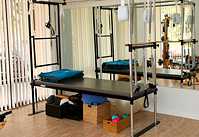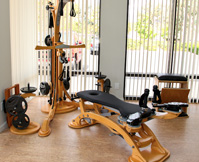SPECIALTIES
Physical Therapy at the Movement Arts Center integrates traditional and complimentary manual physical therapy techniques, often used in combination, to achieve healing.
Craniosacral Mobilization
Craniosacral therapy is a gentle manual therapy method of evaluating and improving the function of a physiologic system called the craniosacral system. Anatomically the craniosacral system is comprised of the cerebrospinal fluid and connective tissue surrounding the brain and spinal cord. This system is related to, influences, and is influenced by the nervous system and as a result influences the musculoskeletal system, the vascular, lymphatic, endocrine and respiratory systems. Dysfunction in one part therefore can adversely affect the others .The aim of the therapist is to restore normal physiologic motion and release connective tissue restrictions. In this way the function of the central nervous system is improved which can then influence healing throughout the body.
The GYROTONIC EXPANSION SYSTEM® uses movements that are both circular and rhythmic to improve flexibility, balance, muscle strength, and overall flexibility and mobility in the joints. This system uses weights and pulleys with principles of yoga, tai chi and ballet to make you more fit and flexible. The gentleness of GYROTONIC® makes it an especially great exercise for those who are recovering from injury or rehabilitating after major surgeries.
Myofascial Release
A very effective hands on technique that provides gentle sustained pressure and slow sustained stretch to fascial tissue to free adhesions and lengthen connective tissue. Myofascial release, because of its attachments and interrelationships with the skeleton, muscles, blood vessels and organs resolves tension on bones, muscles, joints and nerves; circulation and neural transmission is also improved. This results in pain relief, restoration of mobility and assists the body’s balance and symmetry.
Neurologic Rehabilitation
Any insult to the body can adversely effect the nervous system. Neurological rehabilitation includes mobilization of neural tissues and re-education of movement patterns to restore painfree ease of movement.
Physical Therapy
Traditional physical therapy techniques may include deep tissue massage, trigger point release, joint mobilization, neural re-education, therapeutic exercise and posture retraining.
 Pilates
Pilates
Pilates is a system of movements based on yoga, calisthenics and martial arts and is designed to condition the entire body. Pilates exercises focus on deep, core postural muscles which help keep the body balanced and which support the spine and organs. Strong core muscles developed through Pilates help keep the back healthy, hold the body upright and improve balance.
Pre and Post-natal Rehabilitation
Profound changes occcur within a woman’s body during and after pregnancy. The role of physical therapy is to facilitate ease of movement and rebalance mobility so that the mother can transition through these changes with minimal pain and stress. Pre and post-natal physical therapy can include manual therapies, strengthening and mobility.
Somatoemotional Techniques
Therapeutic techniques, including rebalancing of the Autonomic Nervous System and the Vagus Nerve, somatoemotional (SE) release, trauma dialoging, hypnotherapy and NeuroLinguistic Programming (NLP) are tools that integrate the emotional and energetic systems and can reset the body after trauma as well as treat the physical effects that trauma or emotional insult has on the body.
Vestibular Rehabilitation for Vertigo and Balance
The vestibular system is a complex system in the body that integrates information from the brain, eyes, inner ears and joints in order to balance and orient a person in space. Vertigo and imbalance are often the symptoms associated with vestibular disorders. These symptoms can markedly change function and often lead to falls, depression, anxiety, memory problems and inactivity.
The goal of vestibular rehabilitation is to optimize the function of the vestibular system in order to reduce or eliminate vertigo and motion sensitivity and to enhance balance.
In our program, you can expect a comprehensive assessment aided by any diagnostic information from your physician. Any limitations in balance, vertigo or motion sensitivity are noted and a treatment plan is designed. Depending on the source of the problem, you may expect hands-on therapy techniques, exercises, balance retraining and/or learn strategies to minimize these limitations. Every person is unique so every treatment plan is unique and based on their needs.
Visceral Mobilization
Developed by Jean-Pierre Barral DO, MRO, RPT of the Barral Institute, visceral mobilization is the system of manual therapy techniques that are designed to restore mobility, tone tissue movement to the organs of the body and their connective tissues. Chronic irritation and fixed abnormal points of tension can lead to subtle organ dysfunction or musculoskeletal pain through the anatomical attachments. Visceral mobilization is a gentle hands-on technique that works with the dysfunctional organ by locating and alleviating those lines of tension in order to improve function and eliminate pain. This technique is particularly effective in the treatment of post-surgical adhesions,digestive, respiratory and pelvic floor dysfunction.
Developmental Screening for newborns, infants and young kids
Screening for developmental milestones can help identify delays in motor, reflex or cognitive patterns; early intervention is pivotal in maximizing a child’s potential.
Lymphatic Massage and Brain Curriculum
The Chickly Institute program was developed by Bruno Chickly DO, MD. It is a comprehensive program which includes lymphatic manual therapy for healing, circulation and repair along with brain/nervous system therapeutic techniques to address unresolved injuries and trauma. According to Dr. Chickly, “the body often aligns itself around these precise structures and they are often the dominant but unaddressed driving force following illness, trauma, surgery and injury.”

